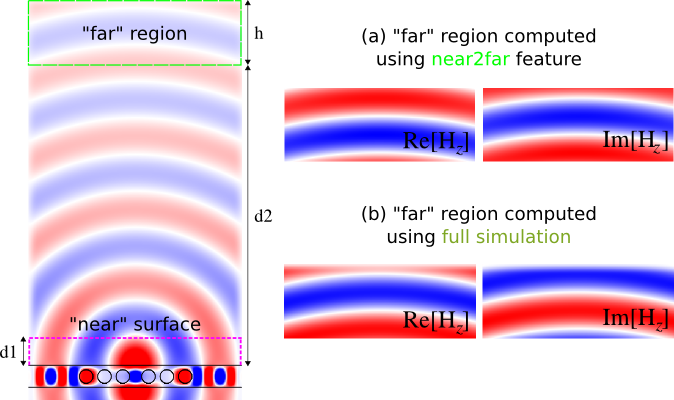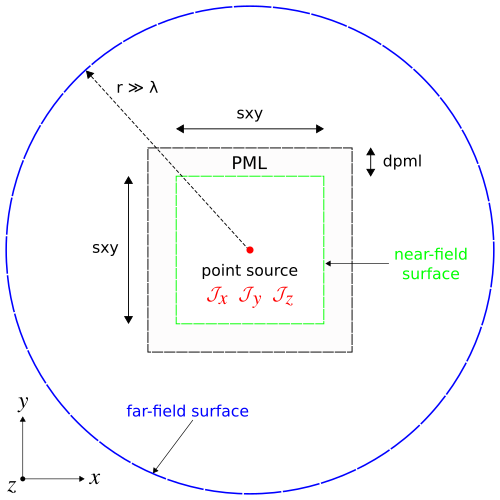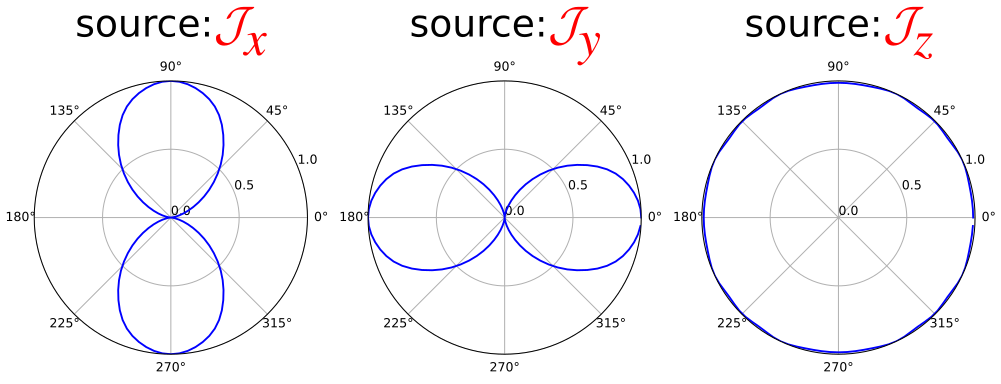Meep Tutorial/Near-to-far-field spectra
From AbInitio
| Revision as of 05:04, 19 April 2017 (edit) Ardavan (Talk | contribs) (→Radiation Pattern of an Antenna) ← Previous diff |
Revision as of 05:45, 19 April 2017 (edit) Ardavan (Talk | contribs) (→Radiation Pattern of an Antenna) Next diff → |
||
| Line 36: | Line 36: | ||
| ==Radiation Pattern of an Antenna== | ==Radiation Pattern of an Antenna== | ||
| - | We can also use the near-to-far-field transformation feature to compute the [[w:Radiation pattern|radiation pattern]] of an antenna. This example involves an electric-current point source as the emitter in 2d vacuum. We will investigate the radiation pattern for different polarizations of the input source. The source is placed in the middle of the 2d computational cell which is surrounded by perfectly-matched layers (PMLs). The near-field surface, used to compute the far fields as described above, is along the inner boundary of the PML. The far fields are computed at several equally-spaced points along the circumference of a circle having a radius many times the source wavelength and thus lying outside of the computational cell. The simulation geometry is shown in the schematic below. | + | We can also use the near-to-far-field transformation feature to compute the [[w:Radiation pattern|radiation pattern]] of an antenna. This example involves an electric-current point source as the emitter in 2d vacuum. We will compute the radiation pattern for different polarizations of the input source. The source is placed in the middle of the 2d computational cell which is surrounded by perfectly-matched layers (PMLs). The near-field surface, used to compute the far fields as described above, is along the inner boundary of the PML. The far fields are computed at several equally-spaced points along the circumference of a circle having a radius many times the source wavelength and thus lying outside of the computational cell. The simulation geometry is shown in the schematic below. |
| [[Image:Near2far_simulation_geometry.png|center|Simulation geometry used to compute the radiation pattern of a point source in 2d.]] | [[Image:Near2far_simulation_geometry.png|center|Simulation geometry used to compute the radiation pattern of a point source in 2d.]] | ||
Revision as of 05:45, 19 April 2017
In this example, we demonstrate Meep's near-to-far-field transformation feature, which requires version 1.3+. This feature uses the fields from a "near" bounding surface inside the computational cell to compute the resulting "far" fields outside the computational cell via an analytical transformation. Note that this only works if the "near" surface and the "far" region lie in a single, homogeneous, non-periodic 2d or 3d medium. The analytical transformation is based on the principle of equivalence: given the Fourier-transformed tangential fields on the "near" surface, Meep computes equivalent currents and convolves them with the analytical Green's functions in order to compute the fields at any desired point in the "far" region. The use of the Fourier-transformed fields for this operation is similar to that for the flux and force spectra: we specify a set of desired frequencies, Meep accumulates the Fourier transforms, and then Meep computes the fields at each frequency for the desired far-field points.
There are three steps to using the near-to-far-field feature: first, we need to define the "near" surface(s) as a set of surfaces capturing all outgoing radiation in the desired direction(s); second, we run the simulation, typically with a pulsed source, to allow Meep to accumulate the Fourier transforms on the near surface(s); third, we have Meep compute the far fields at any desired points with the option to save the far fields from a grid of points to an HDF5 file.
For this demonstration, we will compute the far-field spectra of a resonant cavity mode in a holey waveguide; a structure we had explored in a separate tutorial. To do this, we simply remove the last portion of that control file, beginning right after the line (set! symmetries (list (make mirror-sym (direction Y) (phase -1)))), and insert the following lines:
(define-param d1 0.2)
(define nearfield
(add-near2far fcen 0 1
(make near2far-region (center 0 (+ (* 0.5 w) d1))
(size (- sx (* 2 dpml)) 0))
(make near2far-region (center (+ (* -0.5 sx) dpml) (+ (* 0.5 w) (* 0.5 d1)))
(size 0 d1)
(weight -1.0))
(make near2far-region (center (- (* 0.5 sx) dpml) (+ (* 0.5 w) (* 0.5 d1)))
(size 0 d1))))
Here, we are creating a "near" bounding surface, consisting of three separate regions surrounding the cavity, that captures all outgoing waves in the top-half of the computational cell. Note that the x-normal surface on the left has a weight of -1 (corresponding to the direction of the outward normal vector relative to the x direction) so that the far-field spectra is correctly computed from the outgoing fields, similar to the flux and force features. The parameter d1 is the distance between the edge of the waveguide and the bounding surface, as shown in the schematic above, and we will demonstrate that changing this parameter does not change the far-field spectra which we compute at a single frequency corresponding to the cavity mode.
We then time step the fields until, at a random point, they have sufficiently decayed away (since the computational cell is surrounded by PMLs) and output the far-field spectra over a rectangular area that lies outside of the computational cell:
(run-sources+ (stop-when-fields-decayed 50 Hz (vector3 0.12 -0.37) 1e-8)) (define-param d2 20) (define-param h 4) (output-farfields nearfield (string-append "spectra-" (number->string d1) "-" (number->string d2) "-" (number->string h)) (volume (center 0 (+ (* 0.5 w) d2 (* 0.5 h))) (size (- sx (* 2 dpml)) h)) resolution)
The first item to note is that the far-field region is located outside of the computational cell, although in principle it can be located anywhere. The second is that the far-field spectra can be interpolated onto a spatial grid that has any given resolution but in this example we used the same resolution as the simulation. Note that the simulation itself used purely real fields but the output, given its analytical nature, contains complex fields. Finally, given that the far-field spectra is derived from the Fourier-transformed fields which includes an arbitrary constant factor, we should expect an overall scale and phase difference in the results obtained using the near-to-far-field feature with those from a corresponding simulation involving the full computational volume. The key point is that the results will be qualitatively but not quantitatively identical. The data will be written out to an HDF5 file (having a filename prefix with the values of the three main parameters) that will automatically include the far-field spectra for all six field components, including real and imaginary parts.
We run the above modified control file and in post-processing create an image of the real and imaginary parts of Hz over the far-field region which is shown in insets (a) above. For comparison, we compute the steady-state fields with a continuous source (making sure to force the fields to be complex) over the same region in a separate simulation using a larger computational cell that contains within it the far-field region, from which is obtained the images shown in (b). The difference in the relative phases among any two points within each of the two field spectra is zero, which can be confirmed numerically. Also, as would be expected, it can be shown that increasing d1 does not change the far-field spectra as long as the results are sufficiently converged (i.e., the resolution is made sufficiently large to mitigate discretization effects).
In general, it is tricky to interpret the overall scale and phase of the far fields, because it is related to the scaling of the Fourier transforms of the near fields. It is simplest to use the near2far feature in situations where the overall scaling is irrelevant, e.g. when you are computing a ratio of fields in two simulations, or a fraction of the far field in some region, etcetera.
Radiation Pattern of an Antenna
We can also use the near-to-far-field transformation feature to compute the radiation pattern of an antenna. This example involves an electric-current point source as the emitter in 2d vacuum. We will compute the radiation pattern for different polarizations of the input source. The source is placed in the middle of the 2d computational cell which is surrounded by perfectly-matched layers (PMLs). The near-field surface, used to compute the far fields as described above, is along the inner boundary of the PML. The far fields are computed at several equally-spaced points along the circumference of a circle having a radius many times the source wavelength and thus lying outside of the computational cell. The simulation geometry is shown in the schematic below.
We use the get-farfield routine to compute the far fields by looping over a set of points along the circumference of a circle. The control file is shown below.
(set-param! resolution 50)
(define-param sxy 10)
(define-param dpml 1)
(set! geometry-lattice (make lattice (size (+ sxy (* 2 dpml)) (+ sxy (* 2 dpml)) no-size)))
(set! pml-layers (list (make pml (thickness dpml))))
(define-param fcen 1.0)
(define-param df 0.4)
(define-param src-cmpt Ez)
(set! sources (list (make source (src (make gaussian-src (frequency fcen) (fwidth df))) (center 0) (component src-cmpt))))
(if (= src-cmpt Ex)
(set! symmetries (list (make mirror-sym (direction Y)))))
(if (= src-cmpt Ey)
(set! symmetries (list (make mirror-sym (direction X)))))
(if (= src-cmpt Ez)
(set! symmetries (list (make mirror-sym (direction X)) (make mirror-sym (direction Y)))))
(define nearfield
(add-near2far fcen 0 1
(make near2far-region (center 0 (* 0.5 sxy)) (size sxy 0))
(make near2far-region (center 0 (* -0.5 sxy)) (size sxy 0) (weight -1.0))
(make near2far-region (center (* 0.5 sxy) 0) (size 0 sxy))
(make near2far-region (center (* -0.5 sxy) 0) (size 0 sxy) (weight -1.0))))
(run-sources+ (stop-when-fields-decayed 50 src-cmpt (vector3 0 0) 1e-8))
(define-param r (* 1000 (/ fcen))) ; 1000 wavelengths out from the source
(define-param npts 100) ; number of points in [0,2*pi) range of angles
(map (lambda (n)
(let ((ff (get-farfield nearfield (vector3 (* r (cos (* 2 pi (/ n npts)))) (* r (sin (* 2 pi (/ n npts)))) 0))))
(print "farfield:, " (number->string n) ", " (number->string (* 2 pi (/ n npts))))
(map (lambda (m)
(let ((ffm (list-ref ff m)))
(print ", " (number->string (* ffm (conj ffm))))))
(arith-sequence 0 1 6))
(print "\n")))
(arith-sequence 0 1 npts))
We compute the far fields for 3 different polarizations of the point source by running 3 separate times and setting the src-cmpt parameter to Ex, Ey, and Ez. The output consists of a set of columns containing the far-field points' index (integer), angle (radians), followed by the squared magnitude of each of the six fields (Ex, Ey, Ez, Hx, Hy, Hz). Note that the far fields computed using near2far are always complex even though the near fields are real as they are in this example. From this data, we can compute the in-plane flux in post processing.
We plot the magnitude of the in-plane flux normalized by its maximum value over the entire interval to produce a range of values between 0 and 1. These are shown in the linearly-scaled, polar-coordinate plots below. As expected, the Jx and Jy sources produce dipole radiation patterns while Jz has a monopole pattern.



